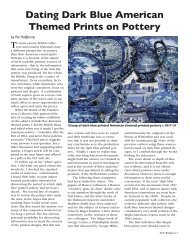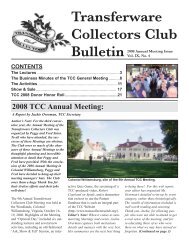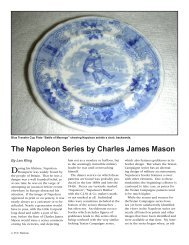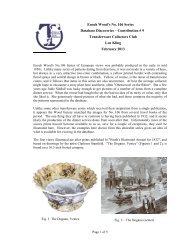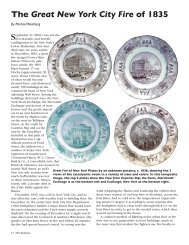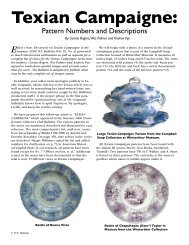A Brief History of Transfer Printed Tiles - Transferware Collectors Club
A Brief History of Transfer Printed Tiles - Transferware Collectors Club
A Brief History of Transfer Printed Tiles - Transferware Collectors Club
You also want an ePaper? Increase the reach of your titles
YUMPU automatically turns print PDFs into web optimized ePapers that Google loves.
health following the cholera epidemics<br />
<strong>of</strong> 1831-32 and 1848-49. These<br />
epidemics provided the impetus for<br />
changes in the sewage system and the<br />
first public sewers were built in 1858-<br />
1874 replacing open cesspools. Upper<br />
class homes had indoor toilets and<br />
bathrooms by mid century and most<br />
homes had indoor plumbing by the<br />
end <strong>of</strong> the century.<br />
The Crystal Palace, London, site <strong>of</strong> the Great Exposition <strong>of</strong> 1851:<br />
Minton tiles featured there were seen by 10s <strong>of</strong> thousands <strong>of</strong> English<br />
consumers.<br />
and twisted borders were produced.<br />
The tiles were printed in black, red or<br />
brown as the traditional Dutch cobalt<br />
blue oxide proved difficult to use on<br />
copper plates.<br />
The business expanded and Sadler<br />
and Green began a partnership with<br />
Josiah Wedgwood and started fairly<br />
extensive decoration <strong>of</strong> Wedgwood’s<br />
creamware even at the expense <strong>of</strong><br />
their own tile making. Over the next<br />
years, others makers started production<br />
<strong>of</strong> printed tiles and, after 12 years,<br />
Wedgwood started his own facility for<br />
printing creamware and tiles.<br />
<strong>Transfer</strong> printed Sadler and Green<br />
tiles were not only used in England,<br />
they were also exported. Fine colonial<br />
homes in America used Sadler and<br />
Green tiles around the fireplaces and<br />
more examples <strong>of</strong> Sadler and Green<br />
tiles remain in situ here than in England.<br />
As anticipated by Shaw and Gilbody,<br />
Sadler and Green’s use <strong>of</strong> transfer<br />
printing contributed to the demise<br />
<strong>of</strong> the British delftware industry.<br />
<strong>Transfer</strong> printed tin-glazed tile use<br />
declined in the 1780’s. This may have<br />
been due to changing fashion or the<br />
tendency for the tiles to craze when<br />
exposed to heat or the previously mention<br />
lack <strong>of</strong> durability. This decline in<br />
tin-glazed tile use signaled the end <strong>of</strong><br />
transfer printed tiles until the middle<br />
<strong>of</strong> the nineteenth century.<br />
The New Age <strong>of</strong><br />
transfer printed tiles<br />
Beginning in 1828, Herbert Minton,<br />
son <strong>of</strong> Thomas Minton founder <strong>of</strong> the<br />
firm, became interested in encaustic<br />
tile production. His interest coincided<br />
with a renewed interest in Gothic<br />
architecture and technological innovations.<br />
Herbert had the foresight to<br />
anticipate the market for tiles and the<br />
wealth and business savvy to do so.<br />
Extolling the virtues <strong>of</strong> tile, he used<br />
his club connections with prominent<br />
architects and Prince Albert to create<br />
demand and cachet. Following the<br />
club demonstration, Queen Victoria<br />
and Prince Albert used Minton encaustic<br />
floor tiles in their home on the Isle<br />
<strong>of</strong> Wight. Building on his successes,<br />
Minton soon expanded his production<br />
into transfer printed and relief wall<br />
tiles. He was quickly joined by other<br />
tile producers.<br />
Concurrent with the significant<br />
mechanical advances that made mass<br />
production <strong>of</strong> tiles possible, there was<br />
an increased awareness <strong>of</strong> disease and<br />
Believing that the odors in the air<br />
carried diseases, reformers began advocating<br />
for building with non-porous<br />
surfaces just as city planners were advocating<br />
for non-flammable building<br />
materials following several devastating<br />
city fires, including one at the Palace<br />
<strong>of</strong> Westminster in 1834. Doctors and<br />
architects campaigned for the use <strong>of</strong><br />
tiles as practical, beautiful, and washable<br />
for use in the new bathrooms,<br />
kitchens, sculleries and food shops.<br />
Style advocates and trendsetters urged<br />
the use <strong>of</strong> tiles around the fireplace.<br />
Desire for tiles was fostered in the<br />
rapidly increasing middle classes by<br />
their exposure to the Great Exposition<br />
<strong>of</strong> the Works <strong>of</strong> Industry <strong>of</strong> All Nations<br />
<strong>of</strong> 1851. Championed by Prince Albert,<br />
the exhibition building covered<br />
700,000 square feet and hosted 17,000<br />
exhibitors from countries as far away<br />
as China. Minton displayed a huge se-<br />
Portrait <strong>of</strong> Herbert Minton,<br />
who’s foresight brought the Minton<br />
Pottery to the forefront <strong>of</strong><br />
English tile production.<br />
18 TCC Bulletin



